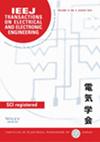Bill Cheng, Congo Tak Shing Ching, Nguyen van Hieu, Pin Chi Tang, Ho Thanh Huy, Nguyen Chi Nhan, Minh-Khue Ha, Chien-Kai Wang, Cheng-Chung Chang, Thien-Luan Phan, Ngoc Thao Nhi Nguyen
求助PDF
{"title":"机器学习在蛋内鸡蛋性别鉴定阻抗数据中的应用","authors":"Bill Cheng, Congo Tak Shing Ching, Nguyen van Hieu, Pin Chi Tang, Ho Thanh Huy, Nguyen Chi Nhan, Minh-Khue Ha, Chien-Kai Wang, Cheng-Chung Chang, Thien-Luan Phan, Ngoc Thao Nhi Nguyen","doi":"10.1002/tee.70125","DOIUrl":null,"url":null,"abstract":"<p>The impedance analysis method, widely employed in human biology, is now gaining attention in biomedical research for a novel application: analyzing impedance signals during the egg incubation process to predict the gender of chickens within the eggs. In the contemporary landscape, Artificial Intelligence (AI) and Machine Learning play pivotal roles in livestock farming, offering cost-effective and labor-efficient solutions. In this study, 35 Taiwanese chicken eggs were used, comprising 20 male and 15 female eggs. During incubation, the impedance values of four electrodes (Z1, Z2, Z3, and Z4) were recorded. A constant voltage signal at 100 mV was applied, alternating between frequencies of 100 kHz and 8 MHz. The findings indicate that the impedance ratio between two pairs of electrodes, Z2 and Z3 compared to Z2 and Z4, on the eleventh day of incubation, reveals differences between male and female eggs within the frequency range of 1–2 MHz. The data set was trained using the Decision Tree approach in conjunction with k-fold cross-validation. The results demonstrate that the model achieved an accuracy of 81.48% in determining the gender of chicken eggs based on their impedance ratio. © 2025 Institute of Electrical Engineers of Japan and Wiley Periodicals LLC.</p>","PeriodicalId":13435,"journal":{"name":"IEEJ Transactions on Electrical and Electronic Engineering","volume":"20 11","pages":"1927-1932"},"PeriodicalIF":1.1000,"publicationDate":"2025-08-06","publicationTypes":"Journal Article","fieldsOfStudy":null,"isOpenAccess":false,"openAccessPdf":"","citationCount":"0","resultStr":"{\"title\":\"Application of Machine Learning to Impedance Data for In-Ovo Chicken Egg Sexing\",\"authors\":\"Bill Cheng, Congo Tak Shing Ching, Nguyen van Hieu, Pin Chi Tang, Ho Thanh Huy, Nguyen Chi Nhan, Minh-Khue Ha, Chien-Kai Wang, Cheng-Chung Chang, Thien-Luan Phan, Ngoc Thao Nhi Nguyen\",\"doi\":\"10.1002/tee.70125\",\"DOIUrl\":null,\"url\":null,\"abstract\":\"<p>The impedance analysis method, widely employed in human biology, is now gaining attention in biomedical research for a novel application: analyzing impedance signals during the egg incubation process to predict the gender of chickens within the eggs. In the contemporary landscape, Artificial Intelligence (AI) and Machine Learning play pivotal roles in livestock farming, offering cost-effective and labor-efficient solutions. In this study, 35 Taiwanese chicken eggs were used, comprising 20 male and 15 female eggs. During incubation, the impedance values of four electrodes (Z1, Z2, Z3, and Z4) were recorded. A constant voltage signal at 100 mV was applied, alternating between frequencies of 100 kHz and 8 MHz. The findings indicate that the impedance ratio between two pairs of electrodes, Z2 and Z3 compared to Z2 and Z4, on the eleventh day of incubation, reveals differences between male and female eggs within the frequency range of 1–2 MHz. The data set was trained using the Decision Tree approach in conjunction with k-fold cross-validation. The results demonstrate that the model achieved an accuracy of 81.48% in determining the gender of chicken eggs based on their impedance ratio. © 2025 Institute of Electrical Engineers of Japan and Wiley Periodicals LLC.</p>\",\"PeriodicalId\":13435,\"journal\":{\"name\":\"IEEJ Transactions on Electrical and Electronic Engineering\",\"volume\":\"20 11\",\"pages\":\"1927-1932\"},\"PeriodicalIF\":1.1000,\"publicationDate\":\"2025-08-06\",\"publicationTypes\":\"Journal Article\",\"fieldsOfStudy\":null,\"isOpenAccess\":false,\"openAccessPdf\":\"\",\"citationCount\":\"0\",\"resultStr\":null,\"platform\":\"Semanticscholar\",\"paperid\":null,\"PeriodicalName\":\"IEEJ Transactions on Electrical and Electronic Engineering\",\"FirstCategoryId\":\"5\",\"ListUrlMain\":\"https://onlinelibrary.wiley.com/doi/10.1002/tee.70125\",\"RegionNum\":4,\"RegionCategory\":\"工程技术\",\"ArticlePicture\":[],\"TitleCN\":null,\"AbstractTextCN\":null,\"PMCID\":null,\"EPubDate\":\"\",\"PubModel\":\"\",\"JCR\":\"Q4\",\"JCRName\":\"ENGINEERING, ELECTRICAL & ELECTRONIC\",\"Score\":null,\"Total\":0}","platform":"Semanticscholar","paperid":null,"PeriodicalName":"IEEJ Transactions on Electrical and Electronic Engineering","FirstCategoryId":"5","ListUrlMain":"https://onlinelibrary.wiley.com/doi/10.1002/tee.70125","RegionNum":4,"RegionCategory":"工程技术","ArticlePicture":[],"TitleCN":null,"AbstractTextCN":null,"PMCID":null,"EPubDate":"","PubModel":"","JCR":"Q4","JCRName":"ENGINEERING, ELECTRICAL & ELECTRONIC","Score":null,"Total":0}
引用次数: 0
引用
批量引用


 求助内容:
求助内容: 应助结果提醒方式:
应助结果提醒方式:


